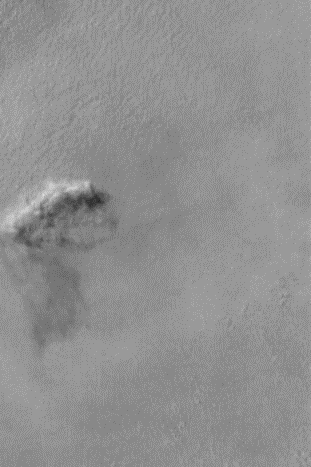


|
Martian Dust Storms MOC PICTURE OF THE DAY CAPTION: From time to time, the Mars Global Surveyor (MGS) Mars Orbiter Camera (MOC) catches--in action--an afternoon dust storm, dust devil, or other dust-raising event. The dust-raising event shown here, probably the result of a sudden strong gust of wind, occurred in November 2003 in a crater located near 57.5°S, 60.6°W. Sunlight illuminates the scene from the upper left, so the dark area below the dust plume is its shadow. The picture covers an area about 3 km (1.9 mi) across. On Mars, the air is 100 times thinner than on Earth—too tenuous to raise dust. Yet Martian dust storms are larger than any seen on Earth. What makes a Martian dust-storm? On Earth, we think dust storms are raised by the wind, and we think we know what makes the wind blow -- sunlight heats the ground; conduction heats the air above it, and convection makes the air move. If the air moves violently enough, as you see in thunderstorms, it can even separate charges and create lightning. On Mars, the air is 100 times thinner and 75 degrees colder. Yet Martian dust storms are larger and taller than any seen on Earth. Occasionally, when Mars is closest to the sun, billowing dust envelopes the whole planet. The viking landing craft discovered the Martian sky was pink from all the dust in it. Scientists expected the sky would be dark because the atmosphere is so thin. They expected Martian winds would be too weak to raise dust, let alone to generate dust devils. NASA scientists studied the dust devils in Arizona in order to understand more about what causes them on Mars. They discovered an unexpectedly high electric field of up to 10,000 volts per meter associated with dust devils on Earth. This suggests that dust devils on both planets are an atmospheric electric discharge phenomenon akin to the electric winds produced by air ionizers. If all planets are involved in a solar electric discharge their atmospheres must be forced to conduct electricity. Mars does not have thunderstorms like the Earth. Instead, in its extremely thin and dry atmosphere, it produces a scaled up version of discharges in the dry air of earthly deserts – dust devils. |
||
|
Copyright 2004: thunderbolts.info |
||